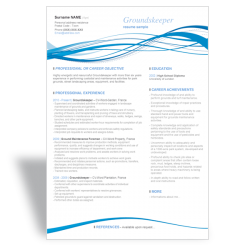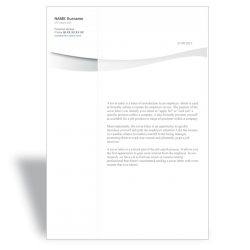No products
Product successfully added to your shopping cart
There are 0 items in your cart. There is 1 item in your cart.
Word CV Résumé template Executive Assistant
Suitable for all professions.This template instantly attract employers’ attention.
3,99 €Word resume CV template Engeneering...
A modern, creative and professional Resume. This Word template is suitable to all professions and specially to engineer, architect, etc.
3,99 €Word resume template marketing director
This template helps you to get noticed by an employer and stand out from the crowd!
3,99 €Word CV Résumé template Construction Manager
Need to be different ? A good Résumé template definitely won't ensure your success !
3,99 €Word CV template Assistant Manager
Download this CV template and create your own CV with your personnal experience
3,99 €
Some advice and guidelines on how to write your CV
Writte a great resume to instantly attract employers’ attention.
Write efficient and outstanding CVs: follow our guidelines and use our CV Word frames
Each template is in a Microsoft Word format. This allows you to save them to your computer and update them when needed.
First of all, take time to write your CV. Remember: your CV is your showcase... It is a commercial document meant to sell something: you! So you have to stand out from the crowd. However, in the process, bear in mind that you still have to comply with the presentation and content rules inherent to this document.
It is also a hook: you do not need to say everything, but enough to arouse interest in the recruiter's mind. It is a sort of summary, and it is complemented by the cover letter, in which you can describe yourself and your achievements and expectations in more depth. If possible, do not hesitate to have your CV read by someone else before you send it. Even better if this person is an employment professional (job centre employee, Human Resources manager...).
WRITING
Your CV must be clear, neat and easily readable! You have to show you know how to synthesise information, this is a crucial point!
So:
- Do not write long sentences, go straight to the point. In one word (or two): be concise.
- Use verbs and third person singular as a rule of thumb.
- Your spelling must be absolutely perfect!
- Put the positive aspects forward: make sure you highlight your achievements.
- Remain honest: omitting details is one thing, but if your employer-to-be finds out false details, inaccurate or treacherous information, this will prove to be the best way to failure.
TITLE
It is sometimes a good idea to give a title to your CV. However, note that some countries are not used to that or simply do not like that.
It can either be the job you are applying to (for ex: Salesperson) or your main qualities (for ex: motivated, serious, resourceful...).
CONTENTS
Your CV must include the following sections:
Your personal details
State your full name, address, phone number(s), fax number, email. Due to discrimination laws that may be in force in certain countries, age and family status are optional, and so is the mention of your religion (for obvious reasons), but here again it all depends on the type of job you are applying for. It is a good thing to check what is expected from the company or what the regional standards are in case you are applying for a job in a foreign country, so please refer to the specific items we listed for you according to the various countries.
Your education and qualifications
List your diplomas and your training, from the most to the least recent.
Do not hesitate to emphasise special classes or degree subjects you took, when relevant.
Indicate special distinctions (cum laude, with honours...) and, when/if applicable, the grades you obtained.
Your work history
Give the details of your professional experience, from the most to the least recent.
Do not forget to mention the skills you acquired in the process... But here again, remember to be concise, so if you have had several jobs, just mention those that are relevant to the company you want to work for.
Other (or further) information or interests and achievements
Do not neglect this section: it gives an insight into your personality and who you are.
Without saying too much, mention two or three activities or hobbies you like (avoid clichés, almost everybody loves going to the cinema!).
This section is usually used by recruiters to orientate the interview towards a less formal conversation or as an icebreaker.
In some cases, it can be relevant to list the driving licence(s) you hold.
Languages and computer skills
They can either be listed under the skills section or, depending on the job you are seeking, appear as a separate section.
As for languages, please state your knowledge and degree of command (basic English, intermediate Spanish, good conversational Dutch, fluent in French, etc.).
Also, if you can translate in one or several pairs of languages, mention it. Delineate your area of expertise: writing, speaking, understanding...
Do the same for computing and list the programs you are familiar with or accustomed to working with. Mention any special training or courses you followed.
Some more ideas
Stating your professional plan
It is a good way to be clear about your intentions. Displayed before all other contents (in title position?), the professional plan gives quick information about what you are looking for or aiming to do.
Skills
If you have acquired and used the same skills throughout your professional career, do not repeat them over and over. Instead, create a Skills section that will list them. Creating a CV based on your skills can be a good idea, especially if you are a mature candidate who has an extensive list of past positions or if you have lots of skills to offer.
Non-corporate work experience
You can talk about your voluntary work experience, or any artistic activity or the small business you have set up and run. Our online frames fit this type of description perfectly, so do not hesitate to give them a closer look.
PICTURE
A photo is not compulsory, but a CV that includes a photo will tend to receive more attention.
The photo can make a difference, but should be of decent quality.
Adopt a businesslike appearance and smile (please avoid holiday, party, blurry or pixelated pictures...). Indeed, you do not want to send a mug shot!
However, due to certain discrimination laws or policies, sometimes a photo is not indicated. Make sure it is suitable for the company or the country you are applying to.
Organize your CV according to...
The business area
Organize your CV so that it fits the job you are looking for. Some jobs have strict rules and standards regarding the writing of the CV, so make sure you find out how to do it right the first time. You may not have a second chance!
The company
Do some research on the background of the company you are going to apply to. The internet is often a very convenient place to start gathering valuable information.
Do not hesitate to carry out a survey on the skills the company is looking for.
You can also do some research on the union sites related to the position you want to apply for.
The job ad
You have to adapt your CV to the job you are looking for.
You need to adapt your CV to the job ad content. However, copying the job ad verbatim is usually a deterrent in the recruiter's mind.
Highlight the specific skills that could enhance your profile, keep the recruiter in mind. Ask yourself: "What is he looking for?"
Advice on the layout
If you have already chosen a CV word frame, make a copy and keep this frame as a basis.
Another piece of extremely useful advice: save your work very regularly!
A model presentation to respect
The trick is to manage to appear original while respecting the rules. To name a few: always target a specific job or career area, lay out your CV carefully and clearly, organize your sections logically and focus on uncompromised readability... On that front, choose the font you will use carefully, prefer classical and easily compatible fonts such as "Times New Roman", "Verdana" or "Arial". Verdana has the advantage of being highly readable on a computer screen, in case you send your CV attached to an email. Besides, CVs are being read more and more often on a computer screen... The ideal font size goes from 10 to 12, with superior size for headings. Do not go under 10, the result would be too small and your text may appear cramped. If you have too much text, it is better to trim a bit and to keep a font size at 10 or above. Colours are to be used with great care. One main colour is enough (see our online frames for that).
Be concise.
Here is a typical description: either for your 'studies' or 'professional experience' sections:
Date + job + company + place
Area:
- enumeration of diverse skills
- enumeration of diverse skills
- enumeration of diverse skills
Example for a professional experience: 2011 | 2011 model maker-CV-Word.com-Leeds
Original CV frames creation
-original frame creation
-writing help via online advices
-etc, etc...
Or for studies: 2004 | Graphic Art degree
Multimedia School of design - Cardiff
Repeat this same presentation for each of your experiences or studies in order to give a concise look to your CV
In order to be sure you keep the same layout as the one of the CV frame (fonts and colour), we advise you to select and replace your text line for line or even word for word.
Special recommendations for writing a US résumé or a résumé targeting an American company:
First of all, a CV in the USA is a different thing. What Europeans call a CV is known as a "résumé" in America. An American CV is actually much longer and written by a researcher or an academic person.
- No heading. Your résumé should start with your contact details.
- As a rule of thumb, do not list your gender, race, religion or marital status. In the United States, employers are compelled by law to be fair and to not discriminate against applicants because of their gender, race, sexual orientation or religious beliefs.
- For the same legal reasons, do not include a photo (unless it is suitable for a particular job).
- You can choose to mention your professional objective right after your personal details. However, this is normally detailed in the cover letter accompanying your résumé, so you may want to avoid repetition.
- Right after your personal details, you should mention your education. If you have a high GPA (Grade Point Average), include it.
- Your résumé must remain concise: no more than 2 pages.
- Attach a cover letter with the résumé.
Special recommendations for writing a CV targeting a French company:
- Your CV has to be clear and easily readable.
- Your CV must target the job you are applying to. It has to fit on one page only... Not easy, huh? So this is time for you to prove you know how to synthesize information!
























